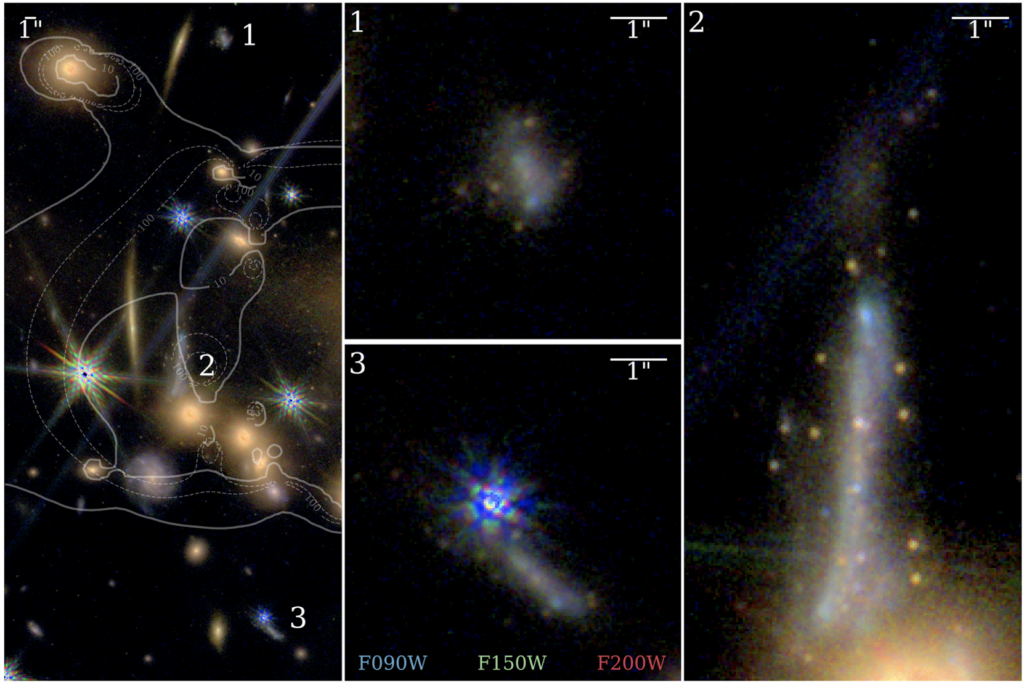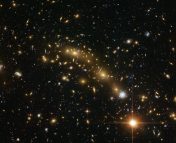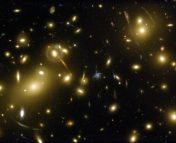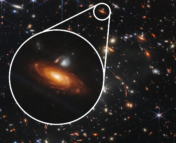Title: The Sparkler: Evolved High-Redshift Globular Clusters Captured by JWST
Authors: Lamiya A. Mowla, Kartheik G. Iyer, Guillaume Desprez, Nelson Caldwell, et al.
First Author’s Institution: Dunlap Institute for Astronomy and Astrophysics, 50 St. George Street, Toronto, Ontario M5S 3H4, Canada
Status: Submitted to ApJL [open access]
It’s only been a month, but the James Webb Space Telescope (JWST) has already captured the hearts of millions with its stunning first images of galaxy clusters, massive nebulae, and views of Jupiter like you’ve never seen before. And with the help of these images, scientists are already making record-breaking discoveries, such as the oldest galaxy ever found, detecting water and CO2 in the atmosphere of an alien exoplanet, and spiral galaxies that are red and dead. These images are a seemingly endless treasure trove of information, and the authors of today’s paper have unearthed some shiny stars in JWST’s first and deepest image.
That image is of the large galaxy cluster SMACS J0723 (shown below). This giant cluster exhibits a phenomena called strong gravitational lensing: it is so massive that it acts like a magnifying glass, bending the light of much more distant objects so strongly that astronomers can see and detect light from sources that are too far away to see otherwise. There are hundreds of lensed objects in the JWST image, but a particularly glittery one caught the authors’ eye: a lensed galaxy surrounded by lots of bright points of light that they aptly named “the Sparkler”, shown below in Figure 1.
If you look at Figure 1, you might think that you’re looking at 3 different objects, none of which look like the typical galaxies you might be used to seeing. Due the wacky geometry of how light bends around massive objects, a lensed galaxy frequently appears like it’s been stretched out from its original disk-like form, and usually we see multiple images of the same galaxy in different positions around the lensing cluster. In this case, we see three images of the Sparkler, the second image being magnified by a factor of anywhere from 10-100x! The authors were interested in figuring out the nature of the point sources surrounding the galaxy – are these highly concentrated conglomerations of stars we call globular clusters, or very dense clumps of stars that are actively forming?
Shine Bright like a Sparkle
In order to answer this question, the authors used imaging and spectra taken from JWST in tandem. Their first step was to select candidate “sparkles” around the galaxy in regions that are uncontaminated by other sources. They then performed aperture photometry on these sources in different filters – drawing a circle around each source and using an algorithm that measures how much light it emits in different wavelengths. This is a measure of a sparkle’s magnitude in various filters. Since the Sparkler is in a very dense region, the authors also injected fake point sources with known fluxes into the images to see how well the algorithm could recover their true fluxes while being in a crowded field.
After finding how much light each source emits, they used that information to make a spectral energy distribution (SED) for each individual sparkle. An SED shows us a plot of how much energy a certain object emits in different wavelengths and can tell us about properties such as age, metallicity, mass, and star formation history of an object.
Each sparkle is labeled in Figure 2 below. The authors IDed them using Image 2, and labeled some of the sparkles’ potential counterparts in Images 1 and 3. Since they figured out each sparkles’ magnitude in different filters, they then measured the difference between different magnitudes – a quantity astronomers call color. They then plotted the colors of each sparkle, along with the color of the Sparkler galaxy itself, in a color-color diagram (Fig 3). Plotting a bunch of sources on such a diagram usually leads to a pattern – sources that are quiescent (no on-going star-formation) will fall along the “red cloud”: an area at the top with redder colors (hence why we sometimes call quiescent galaxies “red and dead”), while sources that are actively star-forming will be at the bottom in the “blue cloud”. Sparkler itself, along with 7 of its sparkles, fall in the blue star-forming region, while 5 of the sparkles fall in the red quiescent region.

Using a program called GALFIT to model the structure and brightness of these 5 red sources, the authors found that they are compact and unresolved by JWST. From the SED model, they also found that these sources were actively star forming very early on in their formation history at extremely high redshifts of z = 7-9. They also looked at spectra of the Sparkler and measured the strength of the [OIII] emission line – an indicator of recent star formation – in its three images. This emission appears in all three images of the Sparkler, but is absent in the locations of the red sparkles they marked earlier.
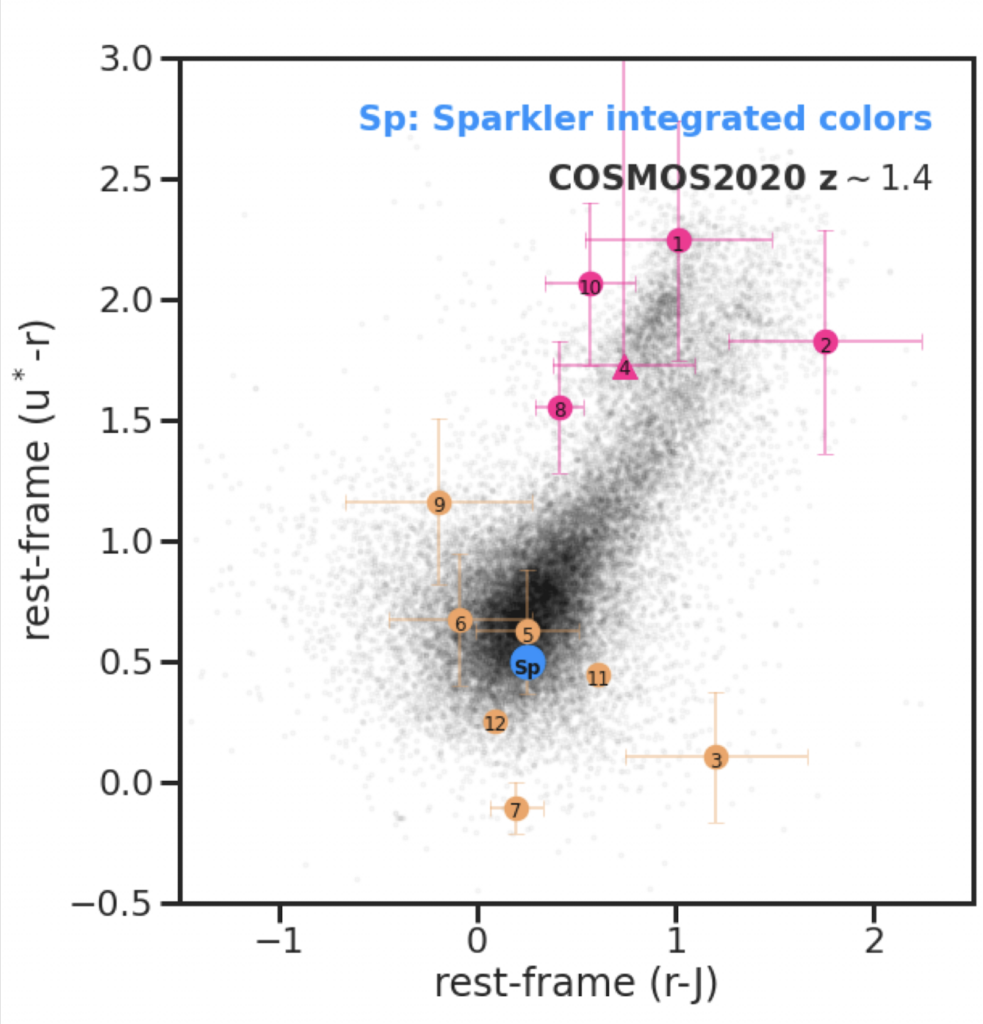
Baby You’re a Firework
All these pieces of evidence – the sparkles’ red colors, unresolved structures appearing in multiple images, and no [OIII] emission – all point to these five sources being old, quiescent globular clusters associated with their host galaxy. This means that these clusters are evolved systems and, from their star-formation histories, most likely formed only 0.5 Gyr after the Big Bang! This would make these sparkles the first ever found globular clusters to have shut off their star formation so early in their evolutionary history.
The authors do warn that there are some caveats to these results. The conclusion that these sparkles are evolved globular clusters depends on the exact magnification of the Sparkler which the authors have yet to determine, so it is possible that a different magnification could yield a different measurement of the sparkles’ mass and put them outside the possible mass range for globular clusters. They also note that results from SED modeling should be taken with a grain of salt as astronomers are very early in the process of understanding how best to calibrate JWST data.
Despite these limitations, the possibility that we’re seeing such systems extremely early in our universe’s history is exciting. If the ages the authors found for the clusters are correct, this indicates that some of these clusters formed at the time as cosmic reionization, the era when the first galaxies were forming and radiating enough energy to turn neutral gas into ionized gas. The specific mechanism by which reionization happened is still a mystery, and this work may provide a link between globular clusters and galaxy formation. Astronomers are also still trying to piece together how globular clusters themselves form, so these sparkles can hopefully ignite a new stage in globular cluster research and establish our hunt for systems at the earliest stages of their lives.
Astrobite edited by Isabella Trierweiler
Featured image credit: NASA, ESA, CSA, and STScI


